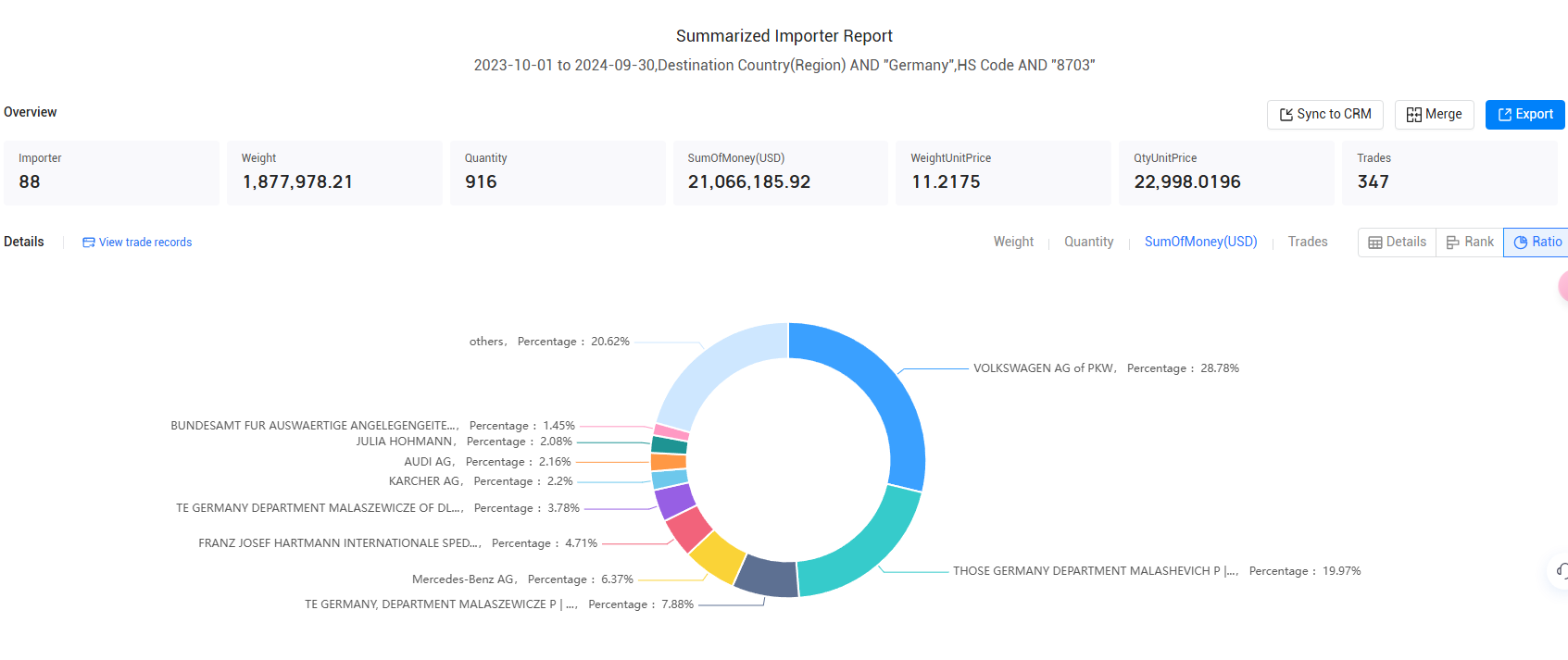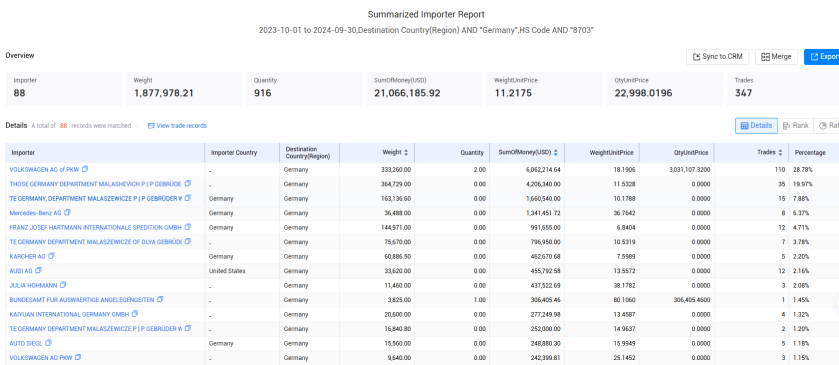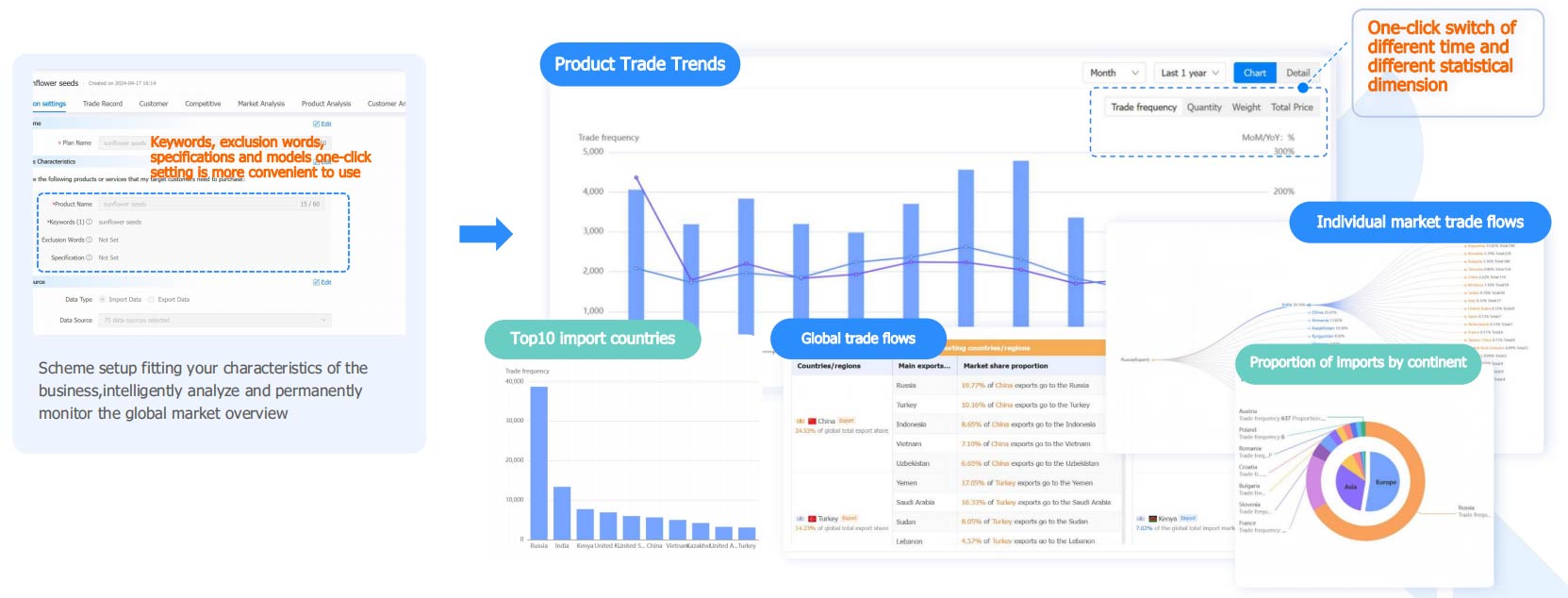 Trade Data Provider
Trade Data Provider
 14-11-2024
14-11-2024
Germany, the largest economy in Europe and the fourth-largest in the world, plays a central role in global trade. As an export-driven economy, it is equally a significant importer of goods, sourcing a diverse range of products from across the globe to support its highly industrialized economy and meet domestic demand. In this article, we explore the sights into Germany's import landscape using German imports data in 2023.

Key Import Partners and Categories
Germany imports goods from nearly every corner of the world. As of recent German imports data, the largest share of imports comes from countries within the European Union, particularly from neighboring countries such as the Netherlands, France, and Italy. Other significant trade partners include China, the United States, and Poland, with China being Germany's largest non-EU import partner.
The import composition reflects Germany's industrial needs and consumer preferences. Key import categories based on German imports data include:
Machinery and Equipment: Germany imports a vast range of machinery, including electrical machinery, computers, and telecommunications equipment. These imports are critical for its manufacturing sector, which relies on advanced technologies for production processes.
Automobile Components and Parts: As the home of major automotive giants such as Volkswagen, BMW, and Daimler, Germany imports a variety of automobile parts and components, including engines, transmissions, and vehicle accessories, to maintain its production line.
Chemicals and Pharmaceuticals: Germany is a major importer of raw chemicals, pharmaceuticals, and plastics. These goods are integral not only to the chemical industry but also to Germany's advanced medical and pharmaceutical sectors.
Energy Products: Given its industrial size, Germany is a major importer of energy resources, particularly crude oil, natural gas, and coal. The country’s push for renewable energy is gradually changing the dynamics of energy imports, but fossil fuels still play a key role.
Consumer Goods and Food Products: In addition to industrial imports, Germany also brings in a variety of consumer goods, including electronics, apparel, and food products, catering to its high standard of living and diverse consumer market.

>>Clike Here for More Information<<
Germany's Top Imports in 2023:
HS Code 8703 (5.35%, $78 billion): - Motor cars and other motor vehicles principally designed for the transport of persons (other than those of heading 87.02), including station wagons and racing cars
HS Code 8708 (3.21%, $47 billion): - Parts and accessories of the motor vehicles of headings 87.01 to 87.05
HS Code 2709 (3.11%, $45 billion): - Petroleum oils and oils obtained from bituminous minerals, crude
HS Code 3002 (2.48%, $36 billion):- Human blood; animal blood for therapeutic, prophylactic or diagnostic uses; antisera, other blood fractions, immunological products, modified or obtained by biotechnological processes; vaccines, toxins, cultures of micro-organisms (excluding yeasts) etc
HS Code 2710 (2.17%, $31 billion):- Petroleum oils and oils from bituminous minerals, not crude; preparations n.e.c. containing by weight 70% or more of petroleum oils or oils from bituminous minerals; these being the basic constituents of the preparations; waste oils
HS Code 2711 (2.15%, $31 billion):- Petroleum gases and other gaseous hydrocarbons
HS Code 3004 (2.11%, $31 billion):- Medicaments (excluding goods of heading 30.02, 30.05 or 30.06) consisting of mixed or unmixed products for therapeutic or prophylactic uses, put up in measured doses (including those in the form of transdermal administration systems) or in forms or packings for retail sale
HS Code 8507 (2.01%, $29 billion):- Electric accumulators, including separators therefor, whether or not rectangular (including square)
HS Code 8517 (1.82%,$26 billion):- Electrical apparatus for line telephony or line telegraphy, including line telephone sets with cordless handsets and telecommunication apparatus for carrier-current line systems or for digital line systems; videophones

>>Clike Here for More Information<<
About Tendata
Tendata iTrader has 210 million global enterprise information, 10 billion data scrolling every day, can quickly and intelligently screen out 700 million executives, decision makers contact information, including email, phone, social media, etc., but also can synchronize the display of the company's yellow pages, product images and web site. At the same time, Tendata provides 19 visualization reports to help foreign trade enterprises accurately locate and analyze the market, so that you can quickly find the precise buyers and suppliers you need.

>>Contact Tendata for A Free Demo<<
Key Trends in German Imports Based on Recent Data
Digitalization and High-Tech Products: One of the most prominent trends in Germany's imports is the increasing demand for high-tech and digital products. This includes advanced machinery for automation, software, and IT equipment, which are essential for Germany’s advanced manufacturing and technological sectors. The rise of digitalization across industries is pushing the demand for new technologies.
Shift Toward Sustainable Imports: German imports data indicates a growing focus on sustainability in trade policies. The importation of renewable energy technologies, such as solar panels, wind turbines, and electric vehicle components, is on the rise as the country works toward achieving its environmental goals. At the same time, imports of goods like palm oil, which have faced scrutiny over environmental concerns, are being closely regulated.
Supply Chain Challenges: Like many global economies, Germany has faced disruptions to its supply chains in recent years, particularly during the COVID-19 pandemic. This has led to delays in imports of raw materials and finished goods, especially in sectors like automotive manufacturing. These challenges have led to increased costs and the need for diversification in supply sources.
Increased Focus on Asia-Pacific: As part of broader global trade trends, German imports data shows a substantial increase in imports from Asia, particularly from China and Japan. This shift reflects the growing manufacturing capabilities and export strengths of countries in the Asia-Pacific region.
Conclusion
German imports data paints a clear picture of a dynamic and diverse import market, driven by Germany's industrial needs and robust consumer demand. The country's import trends show a clear move towards high-tech products, sustainability, and diversification of supply chains. As Germany continues to evolve in response to global challenges, its import profile will likely shift to meet the needs of a digital, green economy, while maintaining its position as a key player in international trade. >>Contact Tendata for A Free Demo<<
Category
Leave Message for Demo Request or Questions


 T-info
T-info T-discovery
T-discovery

 My
Tendata
My
Tendata Market Analysis
Market Analysis Customer
Development
Customer
Development Competitor
Monitoring
Competitor
Monitoring Customer Relationship
Customer Relationship





































































































































